Lies of P has three performance modes - but only 60fps cuts the mustard
PS5 and both Xbox Series consoles tested.
Imitation is the sincerest form of flattery, so Lies of P may be most glowing Dark Souls tribute yet. Built on Unreal Engine 4, From Software fans will feel right at home with Lies of P's mechanics, its focus on learning attack patterns and timing parries. While developers Neowiz Games and Round8 Studio are hardly playing coy about their inspirations, they've delivered a well-executed recreation of a core blueprint that we know works - while arguably surpassing recent From releases in terms of technical polish.
Lies of P's unique setting deserves a few words before we get to how the game performs in its various modes on PS5 and Series X/S, as it represents the biggest twist on the Souls formula. The ruined gothic world of Krat is loosely inspired by the 19th-century, pre-Disney story of Pinocchio; it's a game universe where mechanised puppets have risen up against their human rulers. You'll face deranged creations, from mannequin policemen wielding stop signs to robotic dogs and rogue circus masters. Perhaps the biggest draw of Lies of P is letting that familiar Soulslike blueprint play out while exploring a brand new world.
With that said, what's the best graphics mode to employ on your visit to this curious land of puppetry and pageantry? No matter which console you're playing on, PS5, Series X or S, you have three modes to choose from - each with a slightly different blend of fidelity and performance. There's a 30fps quality mode, a smoother 40fps quality mode for those using 120Hz displays, and a 60fps performance mode. It's rare to see Series S in particular get a full spread of three modes - often, Microsoft's three-litre console has only one or two options.
Let's kick off with a look at the three machines in comparison. The first thing to point out is the resolution difference in the 30fps quality mode that targets higher visual settings. On PS5 and Series X, we're getting a practically fixed 4K with quality mode in place, with no deviations below 3840x2160 detected in numerous pixel tests.
Series S stacks up well by comparison too, with a native 1440p image that gets temporal anti-aliasing to clear up any noise in its upscale to 4K. The image quality on Series S is superb, despite the 4TF profile of the machine itself. Moreover, the three consoles are a match in core visual settings, with the same texture quality and geometric detail across Lies of P's cobble-stoned streets.
However, there are some more subtle tweaks to the Series S presentation, with lower-grade ambient occlusion shading and slightly reduced volumetric fog in certain scenes. For example, rising dust near the stairwell in the early Hotel Krat lobby area is pared back on Series S, as is volumetric fog next to a fountain. In some cases it's a more dramatic change, in others it's more subtle. Reductions in shading are also evident in some scenes viewed side-by-side, with Series X and PS5 offering a richer spread of indirect shadow bounces that add extra depth in between objects and characters like Pinocchio himself. Despite these differences though, Series S still looks superb on its own terms.
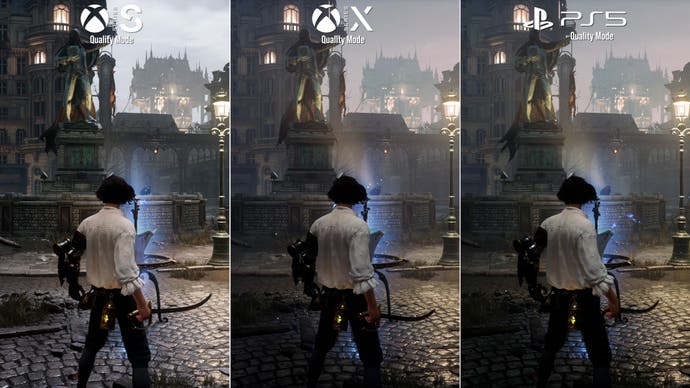
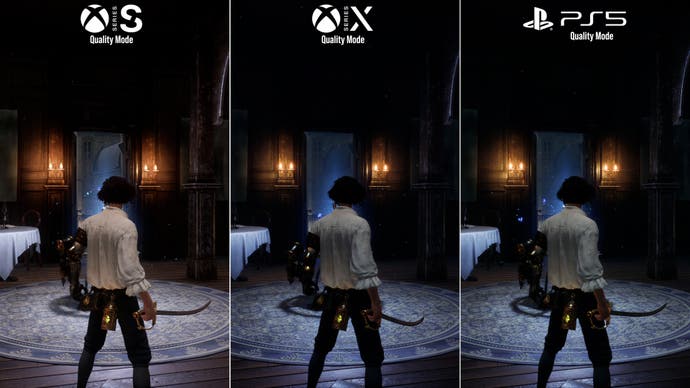
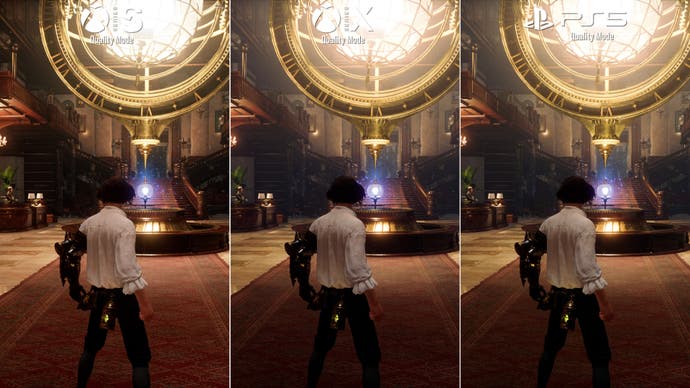
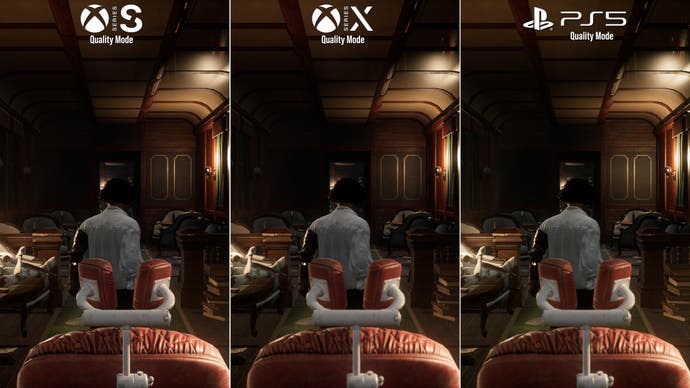
If we jump to performance testing on this 30fps quality mode, there isn't anything to split the three machines in how they play. PS5, Series X and S all run with a fixed 30fps cap through the game's opening chapters, from the station to the factory - even when teaming up with assist characters in effects-heavy boss fights.
The one drawback is obvious, though: uneven frame-pacing. Despite being perfectly fixed at the 30fps line, the ordering of frames is often erratic on the frame-time graph. This contributes to a choppier feel at 30fps, and even makes camera motion and animation look less smooth than they should. This applies to every console version too: PS5, Series X and Series S.
Sadly, it's a design flaw that echoes what we so often see in Souls games of old - especially last-gen efforts like Bloodborne on PS4. This does detract from Lies of P's fluidity in motion, at least in this 30fps quality mode, and is an unfortunate blemish on what is otherwise quite a technically-competent performance.
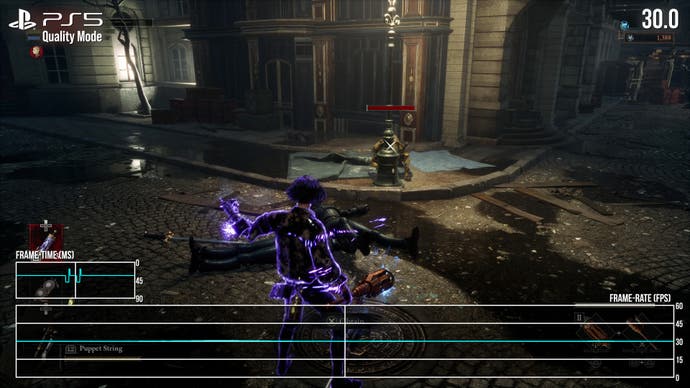
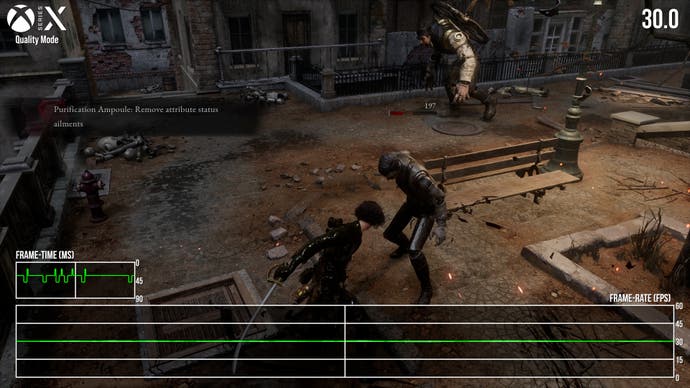
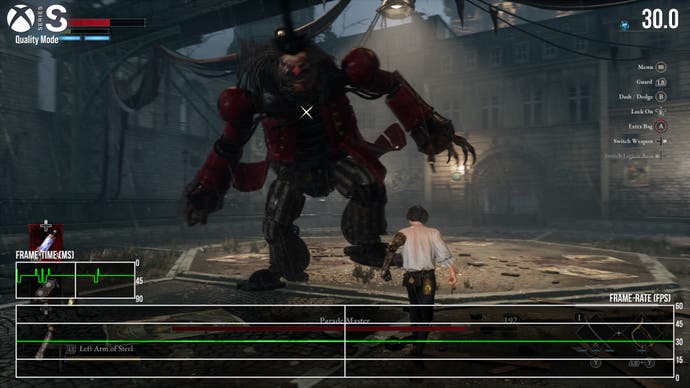
Thankfully, Lies of P has two additional performance modes to choose from. On PS5, Series X and S, there's a high frame-rate toggle which only works with quality mode selected. In short, this keeps the quality mode visual settings in place, but the frame-rate target rises to 40fps instead. This requires a 120Hz display to work, as a 40fps output doesn't go neatly into a 60Hz container - but does work nicely in a 120Hz container. The increase in frames rendered improves the flow of motion over 30fps, while reducing button-to-pixel response times.
The only catch is that, even at 40fps, all three machines still suffer from uneven frame-pacing. However, you're still better off using the 40fps mode if you have the option, though the higher frame-rate is paid for with lower internal resolutions that give the game a softer resolve. As GPU load increases, resolutions drop. On PS5 and Series X, for example, the game runs with an internal resolution of 1872p up to the full 4K. (It's possible that the game drops lower than this, but we didn't spot any lower figures on our pixel counts.) Meanwhile, Series S has a range of pixel counts, from 1200p up to the target maximum of 1440p.
The final option to check out is the 60fps performance mode - which is actually the default setting on PS5, Series X and Series S. That makes sense from a playability perspective, as it solves the frame-pacing issues of the quality modes - you get 60 unique frames per second, each at a steady 16.6ms cadence. The increase in fludity and decrease to input lag makes this the obvious setting to recommend; Lies of P as it was meant to be played.


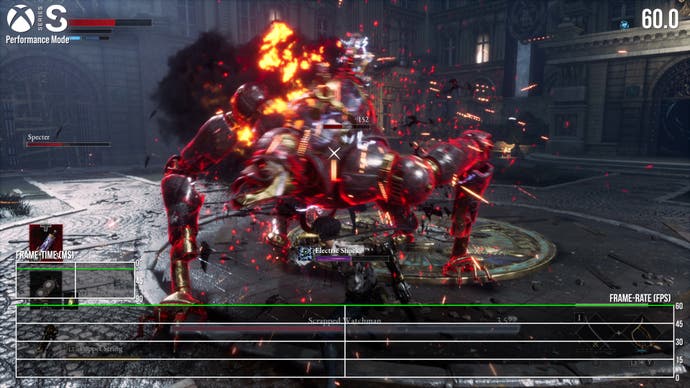
Despite the gameplay improvements in performance mode, there are still a few oddities to be aware. Physics-based elements like flags still animate at 30fps, which looks slightly jarring, while certain enemy animations appear out of sync while at range. This looks strange, but perhaps this makes sense for a clockwork world?
Performance mode also predictably sacrifices resolution, which drops noticeably on every platform. PlayStation 5 and Xbox Series X run at an internal resolution that ranges from 1512p to 1800p. Both machines still hold up reasonably well in the final resolved image, thanks to TAA, but the game does look softer. Series S, meanwhile, runs between 972p up to a new maximum target of 1080p. Still, this feels like a reasonable cutback to hit a clean 60fps.
There are further sacrifices in visual settings on the two premium consoles, with PS5 and Series X both losing the higher-quality shading and volumetric fog that distinguished them from the Series S presentation in their respective quality modes. SSR seems to be affected too. The mist in the opening areas and the deep pockets of shade are relaxed for a lighter, less atmospheric result. And while we've not been able to find any mention of ray tracing features in Lies of P, it does appear that there's a simulated global illumination - a colour bounce from those blue respawn points that changes the hue of certain environments and only engages in quality mode.
Again though, we'd still recommend the performance mode, as having a clean 60fps frame-time readout feels much better than an unevenly frame-paced 30fps with all these settings engaged. After all, every frame counts when you're timing a dodge or parry with just a sliver of health remaining, and the game is hard enough without frame-time delivery issues to contend with.
Based on our testing then, Lies of P is well worth checking out. All three current-gen machines offer a superb way to jump into the experience, with three modes that each justify their place in the options menu. Each has a purpose, a clear benefit and a sensible trade-off.
The only real technical hitch here is the uneven frame-pacing on the quality and high frame-rate modes, at 30fps and 40fps respectively. Given that there's a 60fps option on every console, even Series S, this isn't as big of a deal as it would have been otherwise. It's also impressive to see a game where Series S retains most visual features of the more powerful PS5 and Series X, including SSR.
It's a well balanced, well optimised game on every console, and a big multi-platform effort from developers Neowiz and Round8 Games, including last-gen releases we didn't cover here. Even if it follows a well-known template, sticking the landing to deliver a technically polished experience as well as Lies of P does is no small feat.














